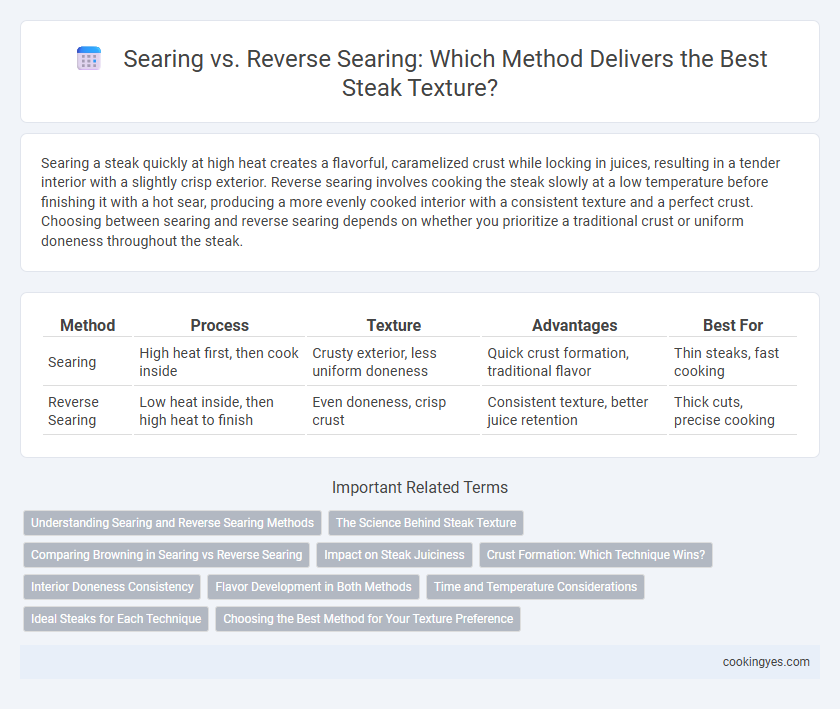Searing a steak quickly at high heat creates a flavorful, caramelized crust while locking in juices, resulting in a tender interior with a slightly crisp exterior. Reverse searing involves cooking the steak slowly at a low temperature before finishing it with a hot sear, producing a more evenly cooked interior with a consistent texture and a perfect crust. Choosing between searing and reverse searing depends on whether you prioritize a traditional crust or uniform doneness throughout the steak.
Table of Comparison
| Method | Process | Texture | Advantages | Best For |
|---|---|---|---|---|
| Searing | High heat first, then cook inside | Crusty exterior, less uniform doneness | Quick crust formation, traditional flavor | Thin steaks, fast cooking |
| Reverse Searing | Low heat inside, then high heat to finish | Even doneness, crisp crust | Consistent texture, better juice retention | Thick cuts, precise cooking |
Understanding Searing and Reverse Searing Methods
Searing involves cooking the steak at high heat initially to create a flavorful crust, locking in juices and enhancing texture through caramelization. Reverse searing starts with slow, low-temperature cooking to achieve uniform doneness, followed by a quick, high-heat sear to form the crust without overcooking the interior. This method yields a more evenly cooked steak with a tender, juicy texture and a distinct, crispy exterior.
The Science Behind Steak Texture
Searing steak creates a Maillard reaction that forms a flavorful crust, enhancing texture by adding a crisp outer layer while locking in juices. Reverse searing involves slow-cooking the steak first to achieve an even internal temperature, resulting in a uniformly tender interior and a precise final crust. This method minimizes moisture loss and improves collagen breakdown, producing a juicier, more consistent texture throughout the steak.
Comparing Browning in Searing vs Reverse Searing
Searing a steak involves high direct heat that rapidly browns the exterior, creating a thick, flavorful crust through the Maillard reaction. Reverse searing starts with low, even heat to cook the steak through before finishing with a brief, intense sear, producing a thinner, more uniform browning layer. The key difference lies in the crust's texture: traditional searing yields a more robust, caramelized surface, while reverse searing offers a tender gradient with controlled browning.
Impact on Steak Juiciness
Searing steak at high heat creates a flavorful crust by Maillard reaction but can cause moisture loss, slightly reducing juiciness. Reverse searing involves cooking the steak slowly at low temperature before finishing with a sear, allowing more even internal doneness and better juice retention. Studies show reverse searing preserves the steak's natural juices, resulting in a more tender and moist texture compared to traditional searing.
Crust Formation: Which Technique Wins?
Searing creates a flavorful crust quickly through direct high heat, resulting in intense Maillard reactions that enhance the steak's texture. Reverse searing allows for more even cooking and a thicker crust by slowly bringing the meat to temperature before finishing with a high-heat sear. For the best crust formation, reverse searing wins by delivering a consistently caramelized exterior with optimal tenderness inside.
Interior Doneness Consistency
Searing steak directly on high heat creates a crust but often leads to uneven interior doneness, with the outer layers overcooked while the center remains underdone. Reverse searing involves slowly cooking the steak at a low temperature before finishing with a high-heat sear, resulting in more consistent interior doneness and a uniformly tender texture. This method ensures even heat penetration, preserving juiciness and achieving a precise, desired level of doneness throughout the steak.
Flavor Development in Both Methods
Searing steak at high heat creates the Maillard reaction, producing a rich, caramelized crust that intensifies flavor and locks in juices for a tender interior. Reverse searing involves slowly cooking the steak at low temperature first, allowing even doneness and enhanced moisture retention, followed by a quick, high-heat sear to develop a flavorful, crispy outer layer. Both methods optimize texture and flavor, but reverse searing offers more control over internal heat and juiciness while traditional searing delivers immediate, robust crust development.
Time and Temperature Considerations
Searing involves cooking steak at high temperatures (around 400-500degF) for a short time to create a crispy crust while maintaining a tender interior, typically taking 2-3 minutes per side. Reverse searing starts with a low, slow cook at about 225-275degF until the steak reaches the desired internal temperature, then finishes with a quick, high-heat sear to develop the crust, enhancing even doneness and maximizing juice retention. Time control is crucial in reverse searing to avoid overcooking, while searing demands precise heat to prevent toughness caused by excessive high-heat exposure.
Ideal Steaks for Each Technique
Searing suits thinner cuts like flank or skirt steak, providing a quick crust while preserving a tender interior. Reverse searing excels with thick cuts such as ribeye or tomahawk, allowing even cooking and a consistent, juicy texture. Choosing the right method depends on steak thickness and desired doneness precision.
Choosing the Best Method for Your Texture Preference
Searing creates a crispy, caramelized crust with a gradient of doneness from edge to center, ideal for those who enjoy a traditional steak texture with a pronounced crust. Reverse searing ensures even cooking throughout with a tender, uniformly pink interior and a delicate crust, perfect for enthusiasts seeking maximum juiciness and consistent texture. Selecting between searing and reverse searing depends on whether you prioritize a crunchy exterior or an evenly cooked, tender bite.
Searing vs Reverse Searing for steak texture Infographic

 cookingyes.com
cookingyes.com